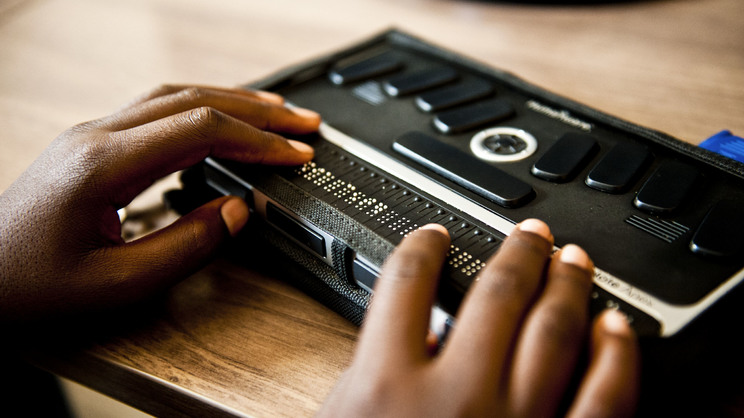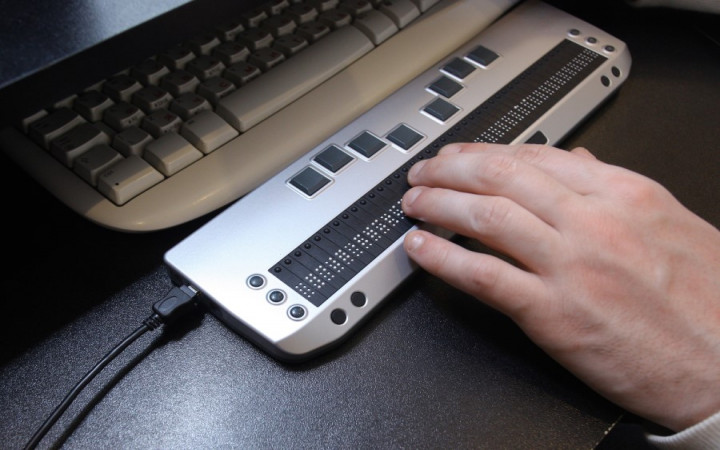Enhancing Lives With Advanced Assistive Instruments for the Blind
The combination of innovative assistive devices for the blind is transforming how people experience their environments and communicate with their areas. What does this development imply for the future of assistive modern technology and its role in empowering individuals?
Review of Assistive Instruments
Assistive gadgets for the blind incorporate a diverse variety of technologies and devices created to boost independence and enhance the lifestyle for people with visual impairments. These tools provide to numerous requirements, from navigation and movement to communication and day-to-day job management.
Among the main categories of assistive tools includes wheelchair aids, such as white walking sticks and overview canines, which assist users browse their surroundings securely. Electronic travel help, furnished with sensing units and audio responses, likewise play a significant role in movement improvement.
In addition, gadgets that aid with daily living activities, such as adaptive kitchen tools, Braille labels, and talking watches, empower individuals to execute jobs individually. Interaction aids, consisting of screen viewers and Braille displays, promote accessibility to information and allow individuals to engage efficiently with the digital globe.
Additionally, low-tech solutions like amplifying glasses and large-print products stay essential for several customers. Collectively, these assistive tools offer not only as sensible tools yet additionally as vital enablers of freedom, cultivating higher engagement in a globe that typically prioritizes sighted experiences. Their combination into day-to-day live is vital for promoting inclusivity and enhancing overall wellness for those with visual problems.
Innovative Technologies being used
Development in modern technology has actually dramatically transformed the landscape of tools readily available for people with visual impairments. Among one of the most notable improvements are wise glasses incorporated with augmented truth, which offer real-time navigating assistance and item recognition. These tools utilize advanced video cameras and expert system to provide acoustic cues, improving the customer's spatial awareness and autonomy.
Additionally, mobile applications have actually arised as effective resources, enabling individuals to recognize currency, read text out loud, and browse unknown settings with spoken instructions. Devices such as Braille displays and refreshable Braille tools remain to evolve, providing smooth connection with computers and mobile phones, therefore enhancing interaction and accessibility to details.
Wearable technology, including smartwatches equipped with voice-activated functions, further equips users by assisting in quick access to notifications and alerts without requiring visual involvement. Responsive maps and 3D printing are also getting grip, offering concrete depictions of rooms that help in orientation and movement training.
Collectively, these cutting-edge innovations not only boost the everyday lives of visually damaged individuals but additionally foster higher self-reliance, inclusivity, and engagement with the more comprehensive community, consequently improving understandings of availability. (OCR devices for the blind)
Personal Stories of Empowerment
Empowerment typically arises from individual experiences that highlight the transformative impact of innovation on individuals with visual impairments. Take, for instance, the story of Sarah, a young artist that regained her enthusiasm for painting through the usage of a wise walking stick geared up with barrier detection. This gadget not only promoted her flexibility yet instilled a newfound confidence, allowing her to navigate public rooms independently and seek her innovative endeavors.

These stories emphasize the profound results that advanced assistive devices can have on day-to-day live. By enabling people to get rid of obstacles, modern technology cultivates a sense of freedom and self-regard. Such empowerment stories act as a testimony to the possibility of development, illustrating how the right tools can dramatically enhance lifestyle and open doors to new possibilities for those with aesthetic disabilities.
Advantages of Advanced Solutions
Exactly how can progressed services essentially boost the lives of individuals with visual problems? The integration of sophisticated innovation into assistive tools dramatically changes everyday experiences for those influenced by vision loss. These innovative options supply unmatched autonomy, making it possible for users to browse their atmospheres with self-confidence. Instruments such as clever canes outfitted with sensors, navigation apps, and wearable innovation are made to provide real-time comments, boosting spatial recognition and reducing the dangers connected with flexibility.
Moreover, progressed assistive modern technologies foster social addition by assisting in communication and communication. Voice-activated tools and applications allow people to access information and involve with their surroundings separately, breaking obstacles that previously impeded their participation in educational, professional, and social setups.
Additionally, the modification and flexibility of these remedies provide to the diverse demands of users, consequently boosting their total lifestyle. Boosted performance, such as object acknowledgment and text-to-speech capacities, equips people with aesthetic disabilities to execute jobs that they may have once discovered challenging. Inevitably, progressed assistive innovations not just enhance self-reliance and safety and security yet also advertise self-respect and self-worth, enabling users to lead fulfilling lives.
Future Fads in Assistive Tech
As modern technology continues to evolve, the landscape of assistive gadgets for the blind is poised for amazing improvements that will certainly further eyeglasses in an hour boost accessibility and freedom. Emerging patterns in assistive innovation suggest a shift toward boosted assimilation of artificial knowledge (AI) and device understanding, allowing gadgets to adapt to individual customer needs in real-time. These innovations are expected to facilitate more intuitive navigating systems that can identify barriers and offer audio comments, significantly improving outside movement.
Additionally, the growth of wearable tech, such as wise glasses furnished with augmented fact, will certainly allow customers to obtain contextual information concerning their environments, therefore enriching their spatial understanding. Advancements in haptic innovation promise to create responsive comments tools, enabling users to perceive info with touch, boosting learning and interaction with their atmosphere.
Telecommunication advances are additionally paving the means for remote aid remedies, where skilled experts can supply advice through video telephone calls, ensuring assistance is readily easily accessible. As these patterns unravel, the future of assistive gadgets for the blind will definitely foster higher freedom, equipping individuals to browse their globe with confidence visit site and simplicity.

Verdict
The combination of sophisticated assistive devices for the blind represents a significant advancement in fostering independence and enhancing lifestyle. By using ingenious innovations, these gadgets equip individuals to navigate their settings with higher confidence and freedom. As the area continues to progress, ongoing r & d will likely yield much more sophisticated remedies, additionally transforming the lived experiences of people with visual problems and advertising a higher sense of incorporation within culture.
The combination of advanced assistive tools for the blind is transforming how people experience their surroundings and connect with their communities. The assimilation of sophisticated modern technology into assistive devices substantially transforms everyday try these out experiences for those influenced by vision loss.As technology continues to develop, the landscape of assistive devices for the blind is poised for exceptional advancements that will certainly even more enhance availability and freedom. Emerging fads in assistive technology show a shift toward boosted combination of fabricated knowledge (AI) and equipment discovering, making it possible for devices to adjust to private user requires in real-time.The assimilation of advanced assistive tools for the blind stands for a substantial advancement in cultivating freedom and boosting top quality of life.